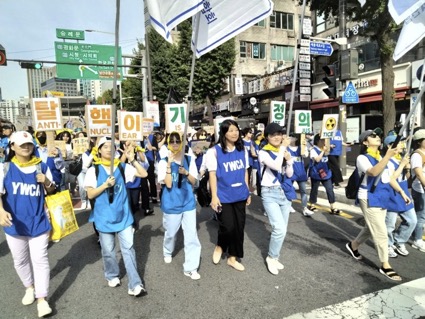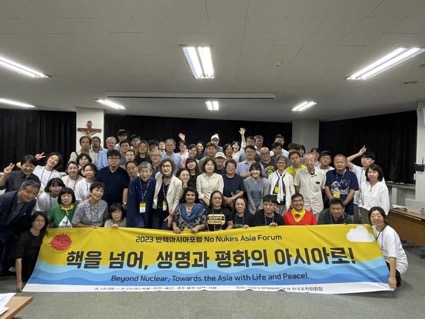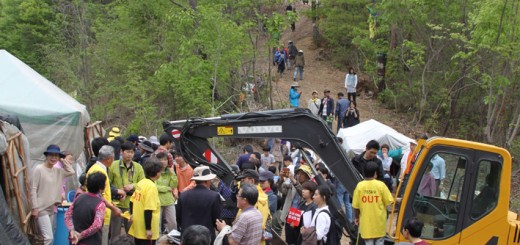No Nukes Asia Forum in South Korea
By Takano Satoshi (CNIC)
The 20th No Nukes Asia Forum (NNAF) was held in South Korea for five days from September 19 to 23. This year’s NNAF gathering marked the 30th anniversary of the first event held in Japan in 1993. About 30 people from seven Asian countries participated. It has been 11 years since the last NNAF meeting in South Korea in 2012, and the author participated as one who has previously lived in Korea for 11 years. As I cannot report on the full details of the entire meeting due to limited space, I will present here a brief report focusing on reports from various countries.
(A full report on the NNAF meeting is given in the NNAF Newsletter No.184. [In Japanese])
Status reports from each country
A report was given by Emily Fajardo from the Philippines, where a nuclear power plant was completed in Bataan Province in 1984. In 1986, however, the Marcos government was overthrown by the pro-democracy movement and operation of the Bataan Nuclear Power Plant, a symbol of corruption, was prevented. Current President Marcos Jr., the son of former President Marcos, is now reportedly considering reviving the Bataan NPP as a measure against the climate crisis. The introduction of small modular reactors (SMRs) is also being promoted and it is rumored that there is a possibility that they could be constructed in as many as 13 locations. Fajardo appealed for the dismantling of the Bataan plant while promoting a renewable energy transition.
Vaishali Patil reported from India. The proportion of nuclear power generation in India’s total power generation is small, at 6,780MW or 1.9% in 2019, but the country is said to be aiming to construct 25,000MW of nuclear power by 2075 to cope with the rapid increase in electricity demand. India has a strong tendency to view nuclear energy as a symbol of prosperity, development and patriotism, and the democratic space in which to advocate against nuclear power has become increasingly narrow, especially under the current right-leaning government. Ms. Patil said that even in the face of such hardship, those who have led the anti-nuclear movement have been women, who are rooted in Mother Earth and that collaboration with the climate justice movement is the key to the future development of the movement.
From Australia, Adrian Glamorgan gave a presentation focusing on the issue of uranium mines. Because uranium mining involves environmental damage and radioactive contamination, it has met with resistance from civil society, particularly centering on indigenous people. Glamorgan pointed out that the environmental remediation of recently closed uranium mines is also a problem, requiring a huge investment of public funds and posing a direct threat to the environment during the remediation period. Nuclear power user countries are also still targeting Australia’s extensive land area in search of radioactive waste disposal sites, and Glamorgan said that there is a need for sustained monitoring and coordination.
Yoshii Michiko of the University of Okinawa introduced the situation in Vietnam. The Vietnamese National Assembly passed a resolution in 2009 to build an NPP, but the decision was scrapped in 2016 due in part to the impact of the Fukushima nuclear accident. However, when South Korean President Yoon Suk Yeol visited Vietnam in June 2023, the two countries signed a memorandum of understanding to promote cooperation in the field of nuclear energy. Yoshii said international solidarity was needed to resist this promotion of nuclear power.
From South Korea, Byun In-hee of Green Korea United reported on the current administration’s policy to promote nuclear power. The Yoon Suk Yeol administration has overturned the previous government’s ban on the construction of new nuclear plants and the prohibition of the extension of operating periods of old NPPs. As a result, the resumption of construction of the New Hanul Units 3 and 4 and the extension of the operating period of Kori NPP Unit 2 are currently being implemented. In addition, South Korea aims to export ten NPPs by 2030 and is also promoting research and development on hydrogen production using SMR and nuclear energy. On the other hand, Byun pointed out that in Gyeongju and Uljin, where these are being promoted, as the local economy is dependent on NPPs, it is difficult for people to raise their voices in opposition and the movement is not spreading.
Prasong Pansri gave a presentation on the situation in Thailand. Thailand introduced a research reactor in the 1960s with the support of the United States, but safety problems were pointed out in 2011, when the nuclear reactor in Bangkok was damaged by flooding. When U.S. Vice President Kamala Harris met with Prime Minister Prayuth in November 2022, it was also reported that efforts to promote nuclear power were being strengthened, including the conclusion of a partnership to develop SMRs.
From Türkiye, Pinar Demircan introduced the project to build an NPP in Akkuyu. The NPP construction project began with a 2010 agreement with Russia and is now under way in Akkuyu. However, there is a fault line, which poses a safety issue, within 30 km of the Akkuyu NPP area. Moreover, it is difficult to gather information about the NPP construction due to concerns about terrorism.
Massive climate justice action held
 I will report briefly on other activities during the NNAF meeting. On the second day, the participants travelled to Busan to hold a press conference on the street close to the Japanese consulate to protest against the release of contaminated water from the Fukushima nuclear accident site. A seminar was held to report on moves to invite a nuclear waste disposal site literature survey in Tsushima City, Nagasaki Prefecture. On the third day, the participants visited Ulsan for an intensive discussion on the nuclear waste issue in Japan and South Korea. On the fourth day, the group travelled to the Wolsong NPP to hear the heartbreaking voices of residents suffering from thyroid cancer and who are appealing for relocation. The participants also heard testimony from residents in Uljin who are campaigning against nuclear power and Samcheok residents who were successful in halting plans for the construction of a new NPP.
I will report briefly on other activities during the NNAF meeting. On the second day, the participants travelled to Busan to hold a press conference on the street close to the Japanese consulate to protest against the release of contaminated water from the Fukushima nuclear accident site. A seminar was held to report on moves to invite a nuclear waste disposal site literature survey in Tsushima City, Nagasaki Prefecture. On the third day, the participants visited Ulsan for an intensive discussion on the nuclear waste issue in Japan and South Korea. On the fourth day, the group travelled to the Wolsong NPP to hear the heartbreaking voices of residents suffering from thyroid cancer and who are appealing for relocation. The participants also heard testimony from residents in Uljin who are campaigning against nuclear power and Samcheok residents who were successful in halting plans for the construction of a new NPP.
On the fifth day, the group returned to Seoul to participate in a climate justice march. In addition to environmental groups, a diverse crowd of 30,000 people, including labor unions, people with disabilities, religious groups, and farmers participated in the march. I was also given an opportunity to speak at the mini-event beforehand. While introducing various cases of suffering and resistance movements related to NPPs reported at the forum, I stressed that nuclear power is a system built on discrimination and victimization. Nuclear power cannot therefore be an alternative solution to the climate crisis. I made an appeal for solidarity as the only way to change the system.
This year’s NNAF meeting confirmed the gloomy situation in Asian countries where nuclear power is being promoted as a measure against the climate crisis. At the same time, there were participants in the march who held signs reading, “Abolishing nuclear power is climate justice.” Let’s fight without fear; we have many comrades in Asia who have woken up to the fictitious nature of the climate crisis measures and are struggling with a passionate spirit for a nuclear-free world.


